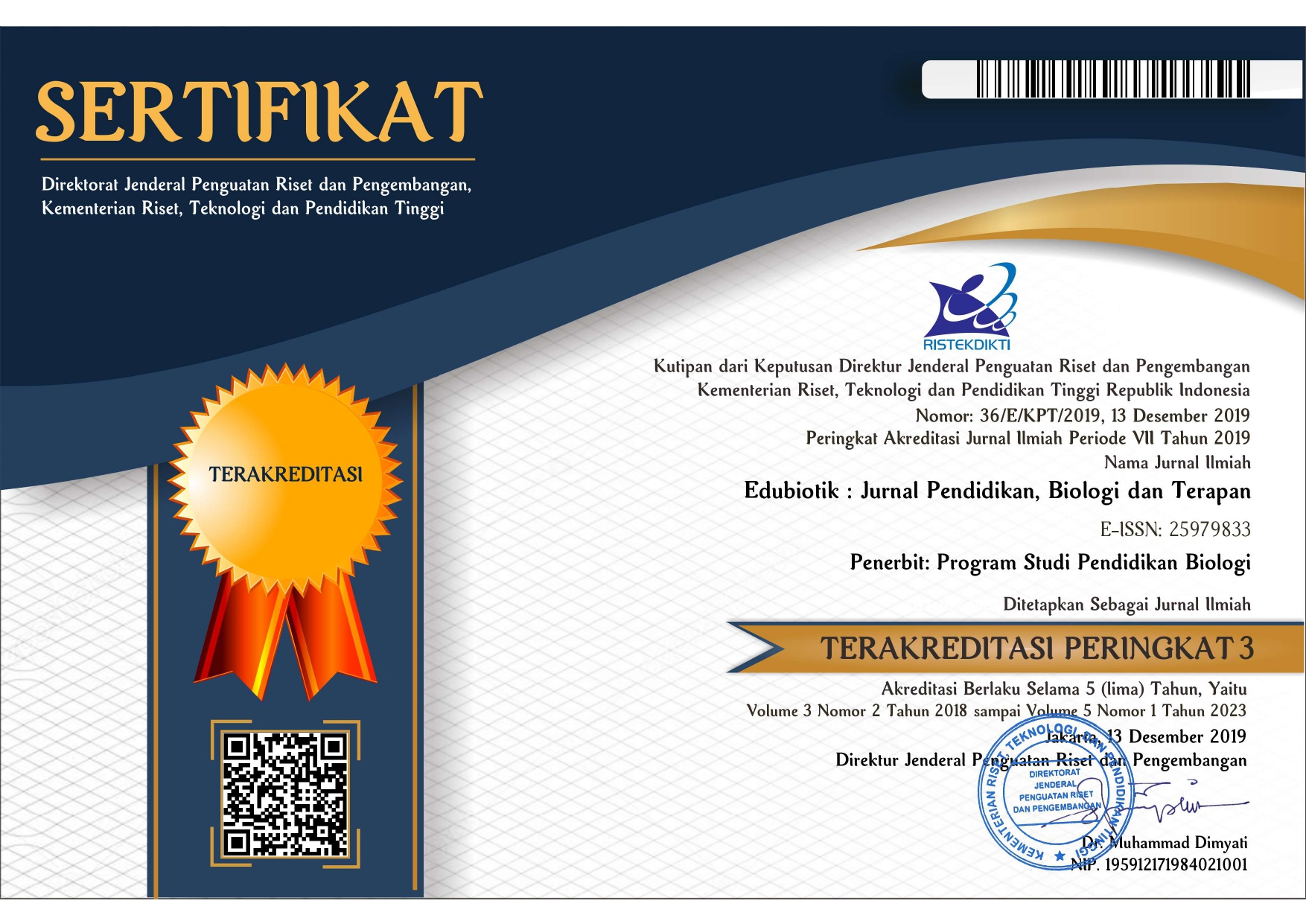Author Guidelines
Edubiotik : Jurnal Pendidikan, Biologi dan Terapan is a scientific journal that publishes articles from scientific research in the field of pure biology and biology education which generally have the following guidelines. (1) Articles are published in English in a single column format. (2) Articles are written in Microsoft Office Word use the Arial Narrow font 12 pt Space 1.15 pt and the 3 margins on the left and 2 for the right, up and downsides.
Systematics of article writing:
TITLE (14 pt; space 1; bold)
The title of the article should be clear, specific and informative. Stating the abbreviation and setting of the research is not recommended
Author's Name (11 pt; space 1; bold)
It is suggested that the article be written collaboratively by two or more authors without stating the academic or non-academic title of the authors. Add code numbers 1,2,3 etc. at the end of the author's name if the author is from a different department or university
Affiliate Address (11 pt; space 1; no bold)
Institution and E-mails of the authors should be stated. Authors 1,2,3 etc. must write the Study Program, Institution / University, City, and Country. The author must write an email to all of the authors. Add code a,b,c, etc at the end of each author's email
ABSTRACT (10 pt; space 1)
Abstract should cover background of the research (excluding any numerical and percentage data), objective of the research, research methods, research findings, and conclusion (10 pt with single space). Keywords: your keywords should be specific and not exceed five words. Each keyword is separated by semi colon (;)
INTRODUCTION (12 pt; space 1,15)
Your introduction should include the following elements. (1) state of the art; (2) research gap/gap analysis; and (3) research objectives. State of the art explains the background of the research which is supported by recent conceptual references in the last 10 years. It is recommended to have as many references as possible in order to support the idea. The research gap/gap analysis should determine the importance and the novelty of the present research compared to the previous ones. The research objective should be developed based on the result of observation or previous research and the research gap. Each paragraph is supported by 5-10 well-structured sentences and these should be written in Arial Narrow with 12 pt and 1.15 pt.
RESEARCH METHODS (12 pt; space 1.15)
The research methods should be put into detail by considering the research instrument used to collect and analyze the data. The research design must be written in paragraphs, not in bullet points or sub-titles. The research design should include (1) the type of the research, (2) the schema of research, (3) the setting of the research, (4) the population and sample of the research, (5) the technique of data collection and data analysis along with the research instruments used. Each paragraph is supported by 5-10 well-structured sentences and these should be written in Arial Narrow with 12 pt and 1.15 pt.
FINDING AND DISCUSSION (12 pt; space 1.15)
The findings of the research should be presented precisely. Tables and figures should be clear and proportional and not captured from other media. Each table and figure should be well-described before they are elaborated on in the paragraphs. The excerpt can be seen in the following (see Table 1 and Figure 1). Table and figure should not be used to explain the same information.
In the Discussion section, instead of repeating the aforementioned theories, authors are encouraged to put their arguments by comparing and contrasting the findings with some relevant previous research findings. The strengths and limitations of the research should be acknowledged in the discussion. Each paragraph is supported by 5-10 well-structured sentences and these should be written in Arial Narrow with 12 pt and 1.15 pt.
CONCLUSION (12 pt; space 1.15)
In this section, put your conclusion in well-structured paragraphs containing 5-10 sentences per paragraph. The conclusion must be written in paragraphs, not in bullet points, and should reflect the research problem and brief reflection of the findings. The conclusion of the research should be postulated conceptually and oriented to research findings in a specific manner that is supported by the data of the research. Each paragraph is supported by 5-10 well-structured sentences and these should be written in Arial Narrow with 12 pt and 1.15 pt.
ACKNOWLEDGMENTS (12 pt; space 1.15)
In this section, the author can state their gratitude toward some parties that have provided financial support (if there is any). Each paragraph is supported by 5-10 well-structured sentences and these should be written in Arial Narrow with 12 pt and 1.15 pt.
REFERENCES (12 pt; space 1)
References should be cited from primary sources and should be at least 15 journal articles. In this case, 80% must be cited from journal articles, while the other 20% can be cited from books. The references should be written using Mendeley with APA Style 7th edition so that there would not be any references that are not written. Do not forget to include the DOI (if there is any) or URL of the article. Each paragraph is supported by 5-10 well-structured sentences and these should be written in Arial Narrow with 12 pt and 1 pt.
More details You can download the J. Edubiotik template here.




.png)
2.png)

1.jpg)


